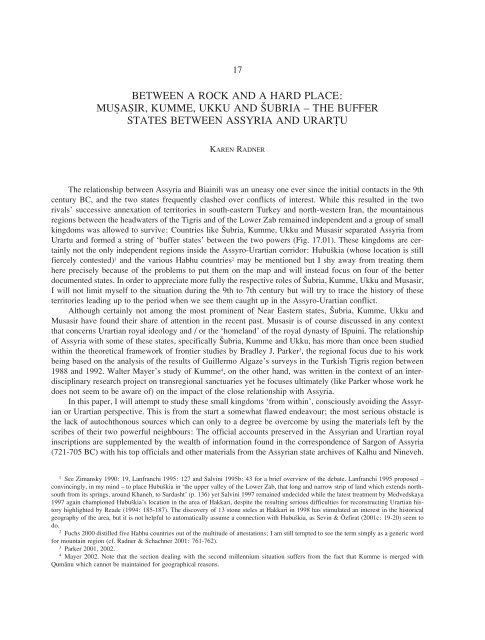Download PDF version of article - UCL
Download PDF version of article - UCL
Download PDF version of article - UCL
Create successful ePaper yourself
Turn your PDF publications into a flip-book with our unique Google optimized e-Paper software.
17<br />
BETWEEN A ROCK AND A HARD PLACE:<br />
MU∑A∑IR, KUMME, UKKU AND SUBRIA – THE BUFFER<br />
STATES BETWEEN ASSYRIA AND URARU<br />
KAREN RADNER<br />
The relationship between Assyria and Biainili was an uneasy one ever since the initial contacts in the 9th<br />
century BC, and the two states frequently clashed over conflicts <strong>of</strong> interest. While this resulted in the two<br />
rivals’ successive annexation <strong>of</strong> territories in south-eastern Turkey and north-western Iran, the mountainous<br />
regions between the headwaters <strong>of</strong> the Tigris and <strong>of</strong> the Lower Zab remained independent and a group <strong>of</strong> small<br />
kingdoms was allowed to survive: Countries like Subria, Kumme, Ukku and Musasir separated Assyria from<br />
Urartu and formed a string <strong>of</strong> ‘buffer states’ between the two powers (Fig. 17.01). These kingdoms are certainly<br />
not the only independent regions inside the Assyro-Urartian corridor: Hubuskia (whose location is still<br />
fiercely contested) 1 and the various Habhu countries 2 may be mentioned but I shy away from treating them<br />
here precisely because <strong>of</strong> the problems to put them on the map and will instead focus on four <strong>of</strong> the better<br />
documented states. In order to appreciate more fully the respective roles <strong>of</strong> Subria, Kumme, Ukku and Musasir,<br />
I will not limit myself to the situation during the 9th to 7th century but will try to trace the history <strong>of</strong> these<br />
territories leading up to the period when we see them caught up in the Assyro-Urartian conflict.<br />
Although certainly not among the most prominent <strong>of</strong> Near Eastern states, Subria, Kumme, Ukku and<br />
Musasir have found their share <strong>of</strong> attention in the recent past. Musasir is <strong>of</strong> course discussed in any context<br />
that concerns Urartian royal ideology and / or the ‘homeland’ <strong>of</strong> the royal dynasty <strong>of</strong> Ispuini. The relationship<br />
<strong>of</strong> Assyria with some <strong>of</strong> these states, specifically Subria, Kumme and Ukku, has more than once been studied<br />
within the theoretical framework <strong>of</strong> frontier studies by Bradley J. Parker 3 , the regional focus due to his work<br />
being based on the analysis <strong>of</strong> the results <strong>of</strong> Guillermo Algaze’s surveys in the Turkish Tigris region between<br />
1988 and 1992. Walter Mayer’s study <strong>of</strong> Kumme 4 , on the other hand, was written in the context <strong>of</strong> an interdisciplinary<br />
research project on transregional sanctuaries yet he focuses ultimately (like Parker whose work he<br />
does not seem to be aware <strong>of</strong>) on the impact <strong>of</strong> the close relationship with Assyria.<br />
In this paper, I will attempt to study these small kingdoms ‘from within’, consciously avoiding the Assyrian<br />
or Urartian perspective. This is from the start a somewhat flawed endeavour; the most serious obstacle is<br />
the lack <strong>of</strong> autochthonous sources which can only to a degree be overcome by using the materials left by the<br />
scribes <strong>of</strong> their two powerful neighbours: The <strong>of</strong>ficial accounts preserved in the Assyrian and Urartian royal<br />
inscriptions are supplemented by the wealth <strong>of</strong> information found in the correspondence <strong>of</strong> Sargon <strong>of</strong> Assyria<br />
(721-705 BC) with his top <strong>of</strong>ficials and other materials from the Assyrian state archives <strong>of</strong> Kalhu and Nineveh.<br />
1 See Zimansky 1990: 19, Lanfranchi 1995: 127 and Salvini 1995b: 43 for a brief overview <strong>of</strong> the debate. Lanfranchi 1995 proposed –<br />
convincingly, in my mind – to place Hubuskia in ‘the upper valley <strong>of</strong> the Lower Zab, that long and narrow strip <strong>of</strong> land which extends northsouth<br />
from its springs, around Khaneh, to Sardasht’ (p. 136) yet Salvini 1997 remained undecided while the latest treatment by Medvedskaya<br />
1997 again championed Hubuskia’s location in the area <strong>of</strong> Hakkari, despite the resulting serious difficulties for reconstructing Urartian history<br />
highlighted by Reade (1994: 185-187). The discovery <strong>of</strong> 13 stone steles at Hakkari in 1998 has stimulated an interest in the historical<br />
geography <strong>of</strong> the area, but it is not helpful to automatically assume a connection with Hubuskia, as Sevin & Özfirat (2001c: 19-20) seem to<br />
do.<br />
2 Fuchs 2000 distilled five Habhu countries out <strong>of</strong> the multitude <strong>of</strong> attestations; I am still tempted to see the term simply as a generic word<br />
for mountain region (cf. Radner & Schachner 2001: 761-762).<br />
3 Parker 2001, 2002.<br />
4 Mayer 2002. Note that the section dealing with the second millennium situation suffers from the fact that Kumme is merged with<br />
Qumanu which cannot be maintained for geographical reasons.

















